Numerical Study of Pressure Fluctuation in a Gas- Liquid Two-Phase Mixed-Flow Pump
Abstract
:1. Introduction
2. Configuration and Mesh of the Gas-Liquid Two-Phase Pump
3. Numerical Methods
3.1. Governing Equations
3.2. Boundary Conditions and Numerical Solutions
3.3. Monitoring Points Settings
4. Results and Discussion
4.1. Validation of Energy Performance and Pressure Fluctuation
4.2. Pressure Fluctuation in the Impeller Passage at Different IGVF Conditions
4.3. Pressure Fluctuation in the Guide Vane Passage at Different IGVF Conditions
4.4. Relationship between the Gas Content and the Pressure Fluctuation in the Impeller/Guide Vane
5. Conclusions
- (1)
- Influenced by the rotor-stator interaction and the gas-liquid phase interaction, pressure fluctuations occur in three IGVF conditions and the dominant frequency of the pressure fluctuation of point C4 is 6 fn (the impeller blade number is 6). Meanwhile, more frequencies with small amplitudes appear under the gas-liquid two-phase condition the than pure water condition.
- (2)
- At different IGVF conditions, the intensity of the fluctuation is firstly enhanced, and then weakened, along the streamwise direction with the maximum located near the impeller outlet (point C4). Additionally, the pressure fluctuations in both the rotor-stator interaction region and the guide vane may be effectively inhibited under small IGVF conditions.
- (3)
- Due to the rotating effect of the impeller, the liquid phase is subjected to a larger centrifugal force than for the gas phase, as the gas gathers in the hub of both the impeller and the guide vane. The relationship between the gas content and the pressure fluctuation was analyzed, and it is shown that the regional pressure fluctuation will be intensified only if the gas content therein reaches a certain level and the local phase interaction is strong.
Acknowledgments
Author Contributions
Conflicts of Interest
Nomenclature
| D | Impeller diameter, m |
| Qd | Design flow rate, kg/s |
| n | Rotational speed, r/min |
| P | Shaft power, kW |
| Hd | Head, m |
| Z | Blade number |
| F2 | Blending function in SST-k-ω model |
| p | Static pressure, kpa |
| w | Relative velocity, m/s |
| ns | Specific speed, m3/4.s−3/2 |
| Δt | Time step, s |
| T | Total time, s |
| Qt | Total flow rate, kg/s |
| a1 | Model constant, dimensionless |
| Cp | Pressure coefficient, dimensionless |
| r | Radial coordinate, dimensionless |
| fn | Frequency of the impeller rotation, 1/s |
| k | Turbulent kinetic energy, m2/s2 |
| Wls | Water superficial velocity, m/s |
| Wgs | Air superficial velocity, m/s |
| Amp | Amplitude of the fluctuation, kpa |
| IGVF | Inlet gas void fraction, dimensionless |
| f | Mass force relevant to the rotation of the impeller, m/s2 |
| S | Standard deviation of the fluctuation, dimensionless |
| Mk | Total interphase force per unit volume, N/m3 |
| N | Maximum iteration number per time step, dimensionless |
| Greek symbols | |
| α | Void fraction, dimensionless |
| ρ | Density of phase k, kg/m3 |
| τ | Viscous stress tensor, pa |
| μt | Turbulent viscosity, pa·s |
| ω | Rotational frequency of the impeller, 1/s |
| Subscripts | |
| k | Phase |
| g | Gas phase |
| l | Liquid phase |
References
- Wang, J.; Zha, H.B.; McDonough, J.M.; Zhang, D.H. Analysis and numerical simulation of a novel gas-liquid multiphase scroll pump. Int. J. Heat Mass Tranf. 2015, 91, 27–36. [Google Scholar] [CrossRef]
- Gong, H.; Falcone, G.; Teodoriu, C.; Morrison, G. Comparison of multiphase pumping technologies for subsea and downhole applications. Oil Gas Facil. 2012, 1, 36–46. [Google Scholar]
- Zhang, J.Y.; Cai, S.J.; Li, Y.J.; Zhu, H.W.; Zhang, Y.X. Visualization study of gas–liquid two-phase flow patterns inside a three-stage rotodynamic multiphase pump. Exp. Therm. Fluid Sci. 2016, 70, 125–138. [Google Scholar] [CrossRef]
- Wang, W.W.; Liang, X.; Zhang, M.Z. Measurment of gas-liquid two-phase slug flow with a Venturi meter based on blind source separation. Chin. J. Chem. Eng. 2015, 23, 1447–1452. [Google Scholar] [CrossRef]
- Matsui, G. Automatic identification of flow regimes in vertical two phase flow using differential pressure fluctuations. Nucl. Eng. Des. 1986, 95, 221–231. [Google Scholar] [CrossRef]
- Mosdorf, R.; Górski, G. Detection of two-phase flow patterns using the recurrence network analysis of pressure drop fluctuations. Int. Commun. Heat Mass 2015, 64, 14–20. [Google Scholar] [CrossRef]
- Hanafizadeh, P.; Eshraghi, J.; Taklifi, A. Experimental identification of flow regimes in gas–liquid two phase flow in a vertical pipe. Meccanica 2016, 51, 1771–1782. [Google Scholar] [CrossRef]
- Al-Safran, E. Investigation and prediction of slug frequency in gas/liquid horizontal pipe flow. J. Pet. Sci. Eng. 2009, 69, 143–155. [Google Scholar] [CrossRef]
- Thaker, J.; Banerjee, J. Characterization of two-phase slug flow sub-regimes using flow visualization. J. Pet. Sci. Eng. 2015, 135, 561–576. [Google Scholar] [CrossRef]
- Kabiri-Samani, A.; Borghei, S.M. Pressure loss in a horizontal two-phase slug flow. J. Fluids Eng. 2010, 132, 1–8. [Google Scholar] [CrossRef]
- Lin, P.Y.; Hanratty, T.J. Detection of slug flow from pressure measurements. Int. J. Multiph. Flow 1987, 13, 13–21. [Google Scholar] [CrossRef]
- Dinaryanto, O.; Prayitno, Y.A.K.; Majid, A.I.; Hudaya, A.Z.; Nusirwan, Y.A.; Widyaparaga, A. Experimental investigation on the initiation and flow development of gas-liquid slug two-phase flow in a horizontal pipe. Exp. Therm. Fluid Sci. 2017, 81, 93–108. [Google Scholar] [CrossRef]
- Tremante, A.; Moreno, N.; Rey, R. Numerical turbulent simulation of the two–phase flow (1iquid/gas) through a cascade of an axial pump. ASME J. Fluids Eng. 2002, 124, 371–376. [Google Scholar] [CrossRef]
- Trevisan, F.E.; Prado, M.G. Experimental investigation of the viscous effect on two-phase flow patterns and hydraulic performance of electrical submersible pumps. J. Can. Pet. Technol. 2010, 50, 45–52. [Google Scholar] [CrossRef]
- Lu, J.L.; Xi, G.; Qi, D.T. Numerical study on the gas-liquid two-phase 3-D flow in the impeller of a centrifugal pump. J. Eng. Thermophys. 2003, 24, 237–240. [Google Scholar]
- Poullikkas, A. Two phase flow performance of nuclear reaction coolant pumps. Prog. Nucl. Energy 2000, 36, 123–130. [Google Scholar] [CrossRef]
- Poullikkas, A. Effects of two-phase liquid-gas flow on the performance of nuclear reactor cooling pumps. Prog. Nucl. Energy 2003, 42, 3–10. [Google Scholar] [CrossRef]
- Yu, Z.Y.; Zhu, B.S.; Cao, S.L.; Liu, Y. Effect of virtual mass force on the mixed transport process in a multiphase rotodynamic pump. Adv. Mech. Eng. 2015, 6. [Google Scholar] [CrossRef]
- Huang, S.; Wang, H.J.; Zheng, M.X. Numerical analysis of gas-liquid two-phase flow in multiphase rotodynamic pump and pump performance. J. South China Uni. Technol. (Nat. Sci. Ed.). 2007, 35, 11–16. [Google Scholar]
- Lee, D.; Best, F.R.; McGraw, N. Microgravity two-phase flow regime modeling. In Proceedings of the American Nuclear Society winter meeting, Los Angeles, CA, USA, 15 November 1987. [Google Scholar]
- Benhmidene, A.; Chaouachi, B.; Bourouis, M.; Gansi, S. Numerical prediction of flow patterns in bubble pumps. J. Fluid Eng. 2011, 133, 031302. [Google Scholar] [CrossRef]
- Situ, R.; Hibiki, T.; Brown, R.J. Flow regime transition criteria for two-phase flow at reduced gravity conditions. Int. J. Multiph. Flow 2011, 37, 1165–1177. [Google Scholar] [CrossRef]
- Liu, D.Y. Fluid Dynamics of Two-Phase Systems; Higher Education Press: Beijing, China, 1993; pp. 26–31. [Google Scholar]
- Johnson, R.W. The Handbook of Fluid Dynamics; CRC Press: Boca Raton, FL, USA, 1998; pp. 21–22. [Google Scholar]
- Yu, Z.Y.; Zhu, B.S.; Cao, S.L. Interphase force analysis for air-water bubbly flow in a multiphase rotodynamic pump. Eng. Comput. 2015, 32, 2166–2180. [Google Scholar] [CrossRef]
- Zhang, K.W. Theory of Fluid Machinery, Volume 1; China Machine Press: Beijing, China, 2000; pp. 76–80. [Google Scholar]
- Li, X.J.; Yuan, S.Q.; Pan, Z.Y.; Li, Y.; Liu, W. Dynamic characteristics of rotating stall in mixed flow pump. J Appl. Math. 2013, 8, 1–12. [Google Scholar] [CrossRef]
- Zhang, W.W.; Yu, Z.Y.; Zhu, B.S. Influence of tip clearance on pressure fluctuation in low specific speed mixed-flow pump passage. Energies 2017, 10, 148. [Google Scholar] [CrossRef]
- Yu, Z.Y.; Wang, G.Y.; Cao, S.L. Extended two-fluid model applied to analysis of bubbly flow in multiphase rotodynamic pump impeller. Front. Mech. Eng. 2009, 4, 53–59. [Google Scholar] [CrossRef]
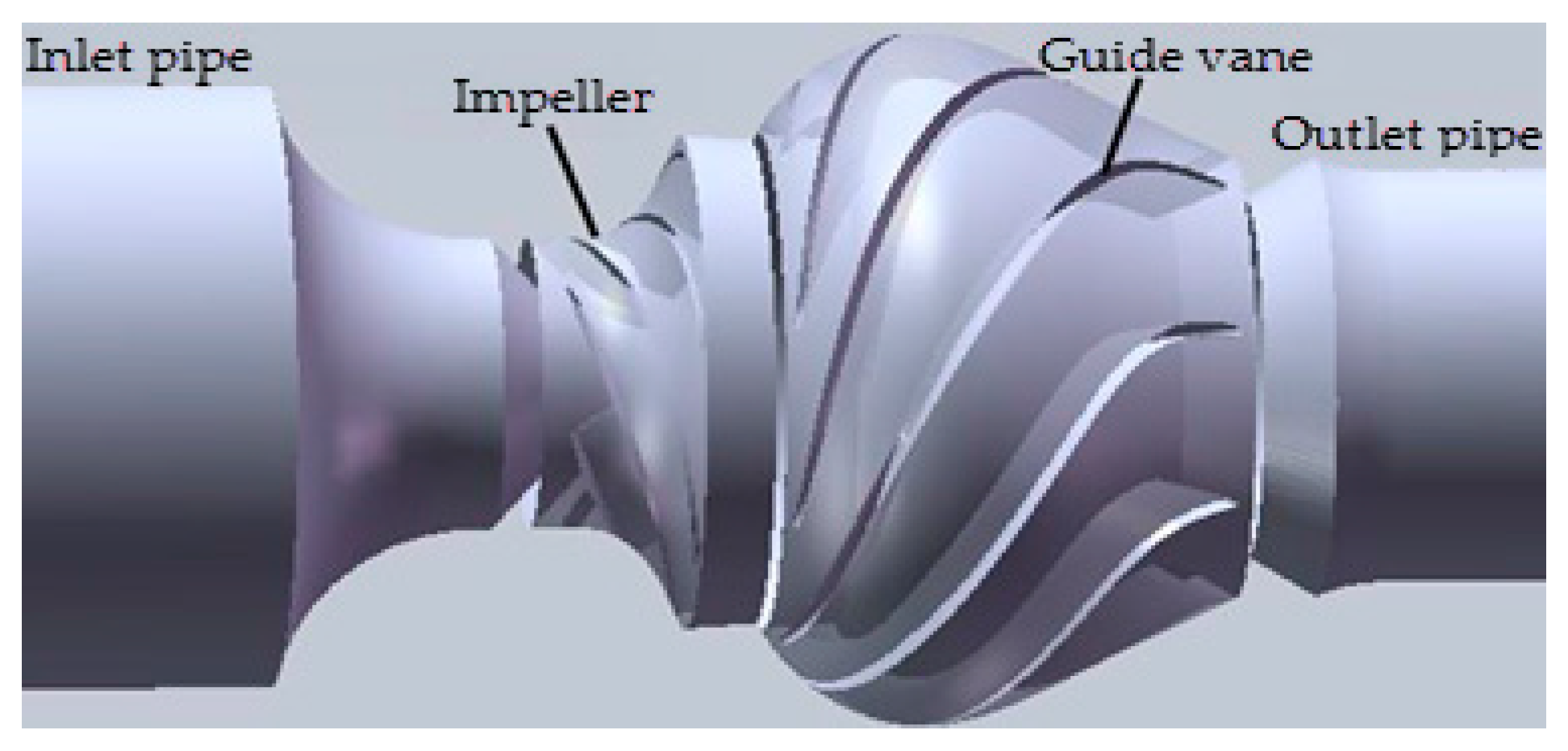
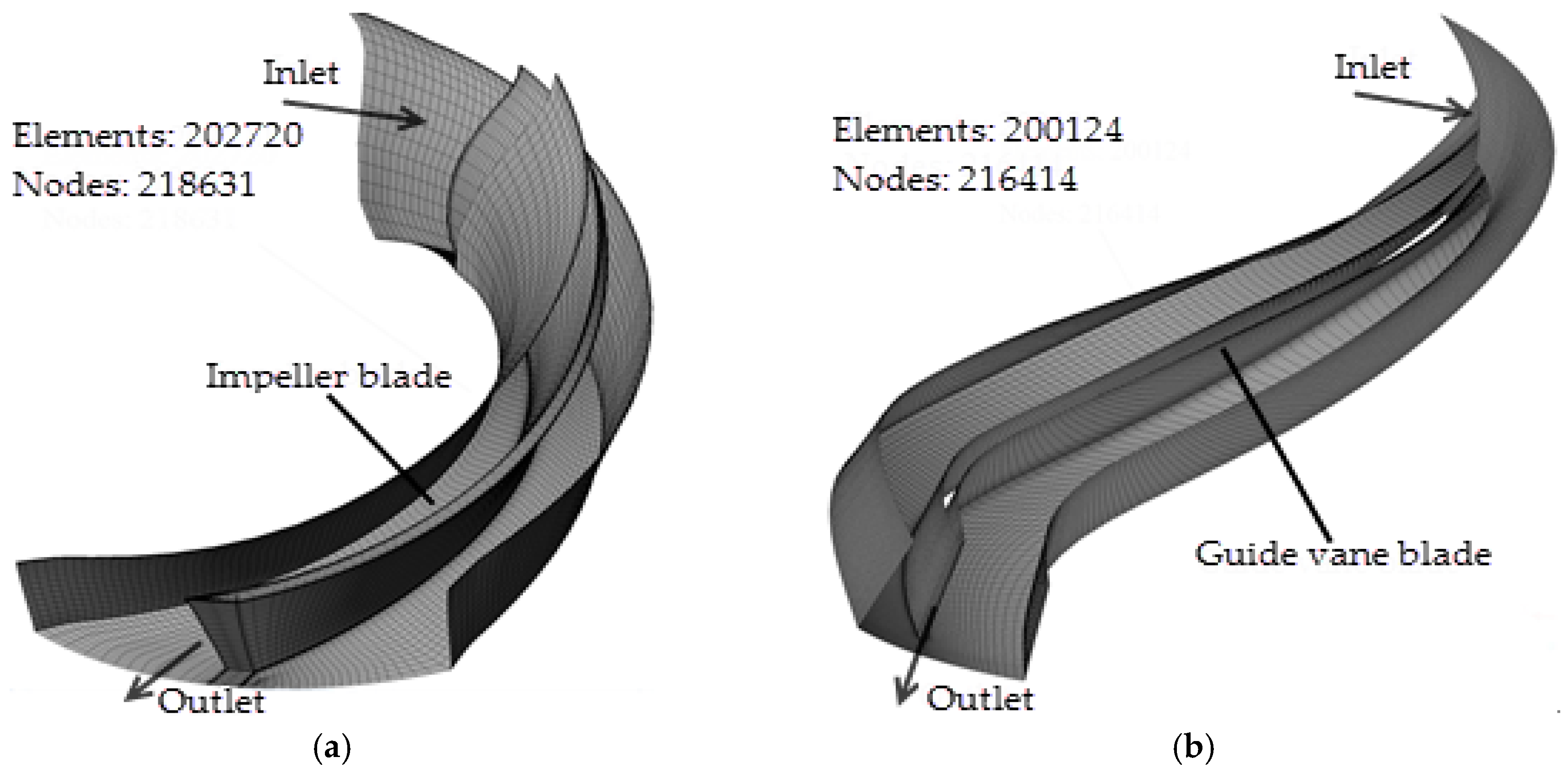
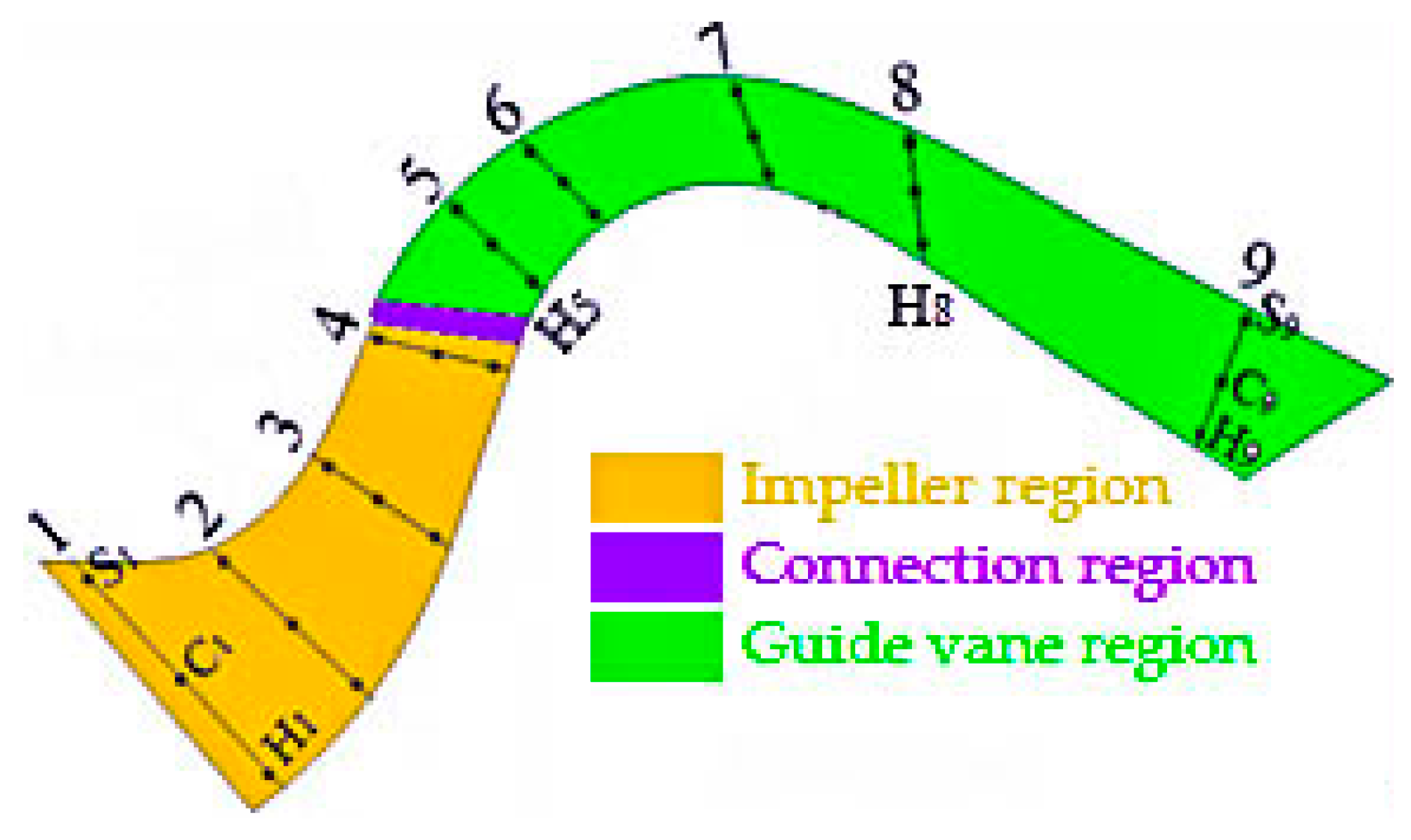
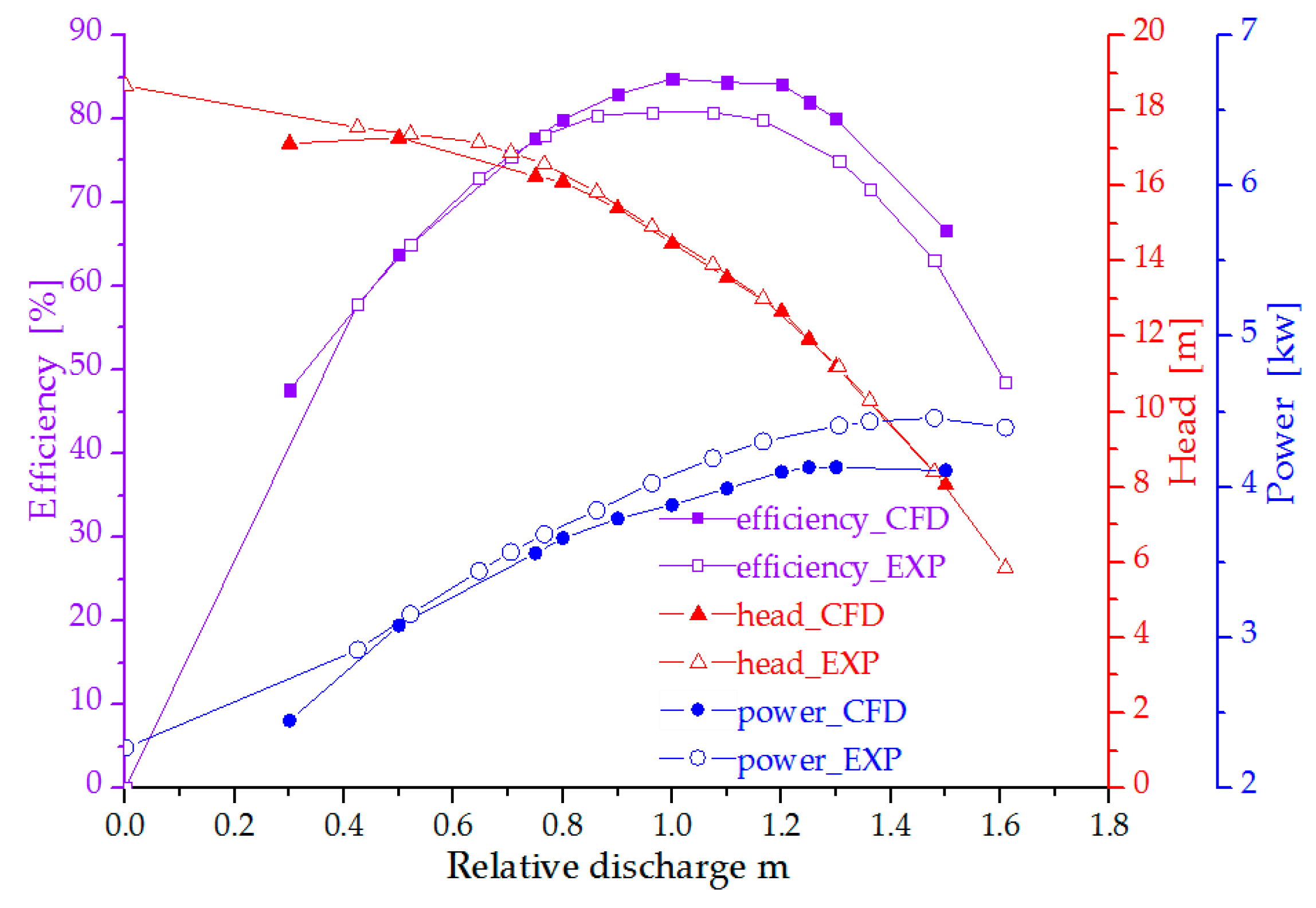
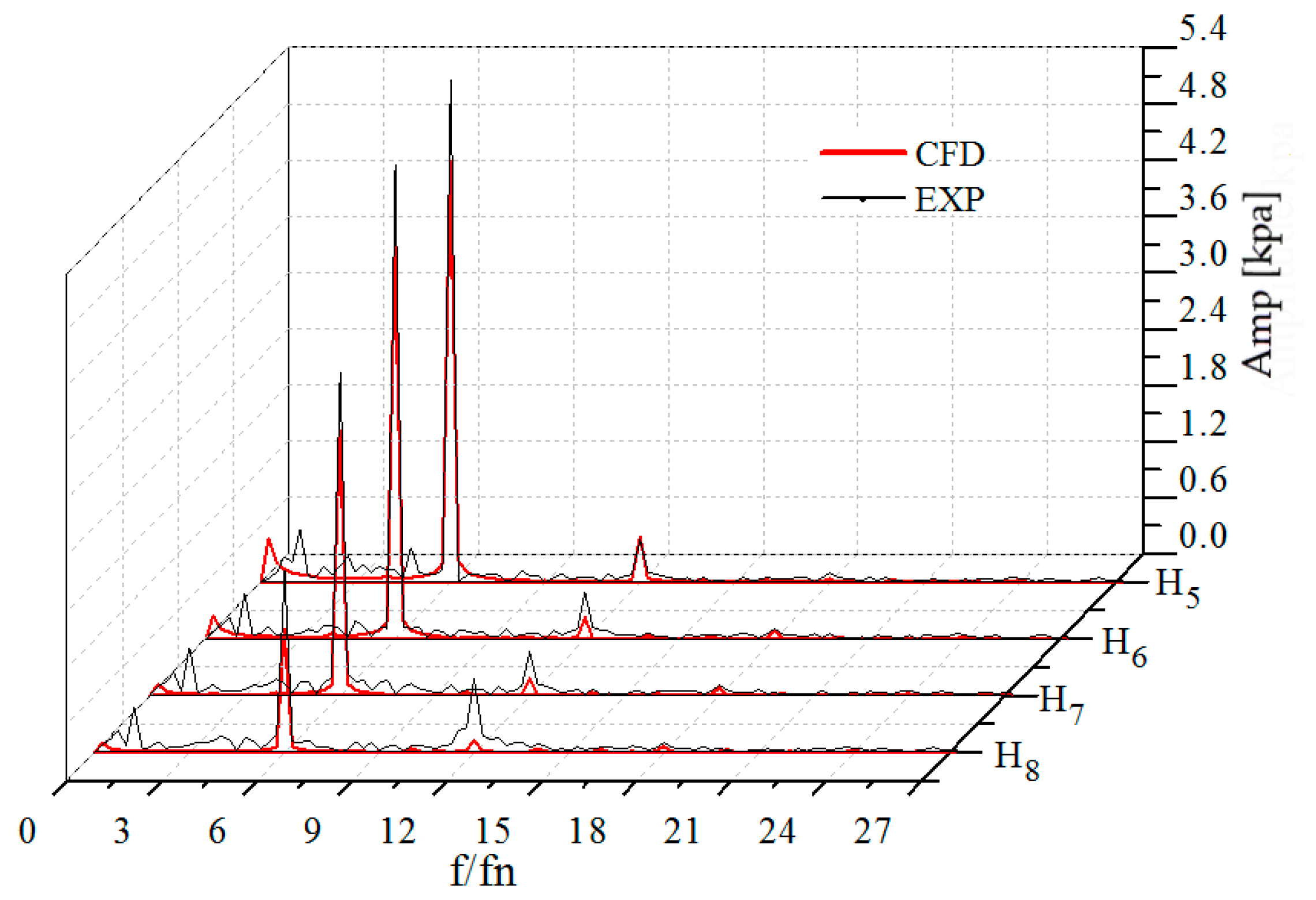

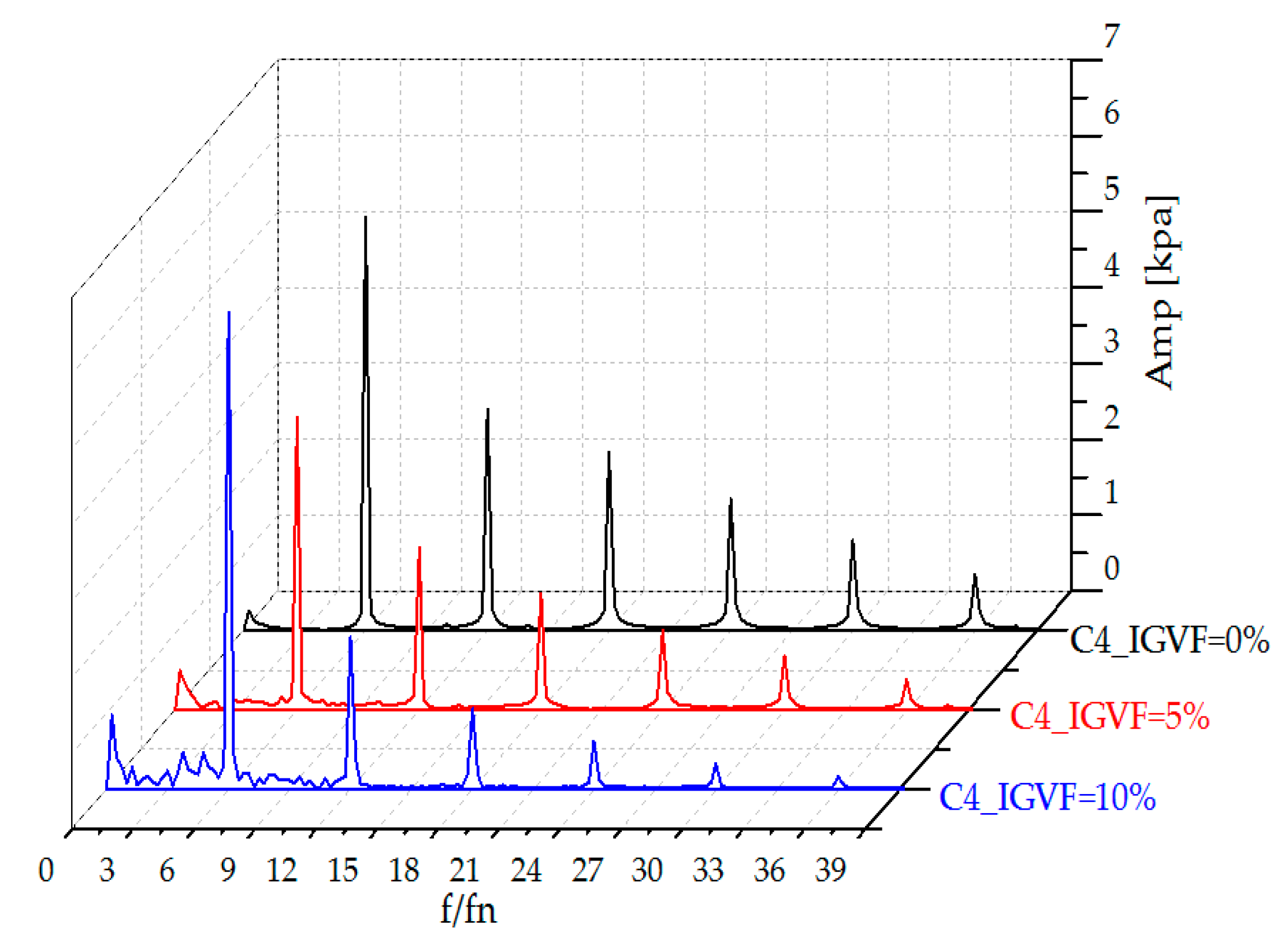
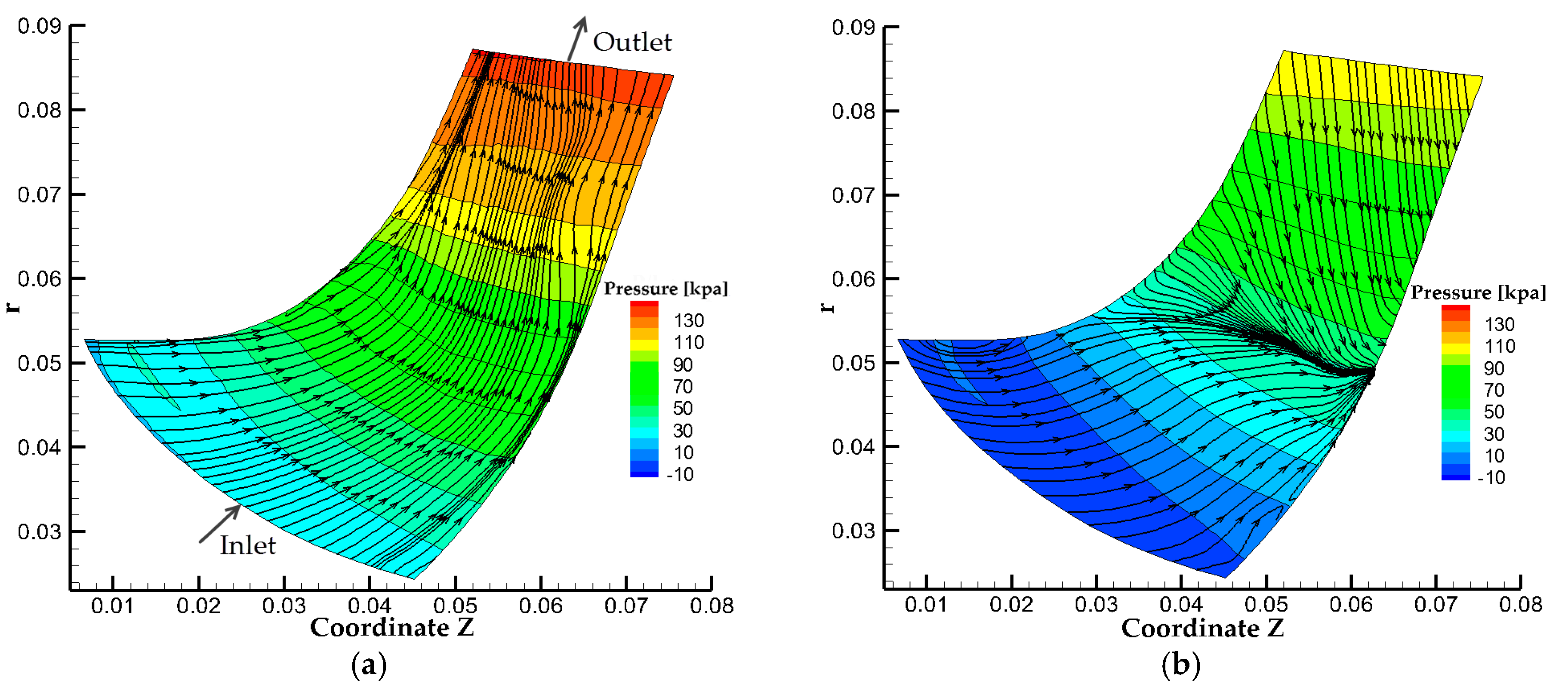

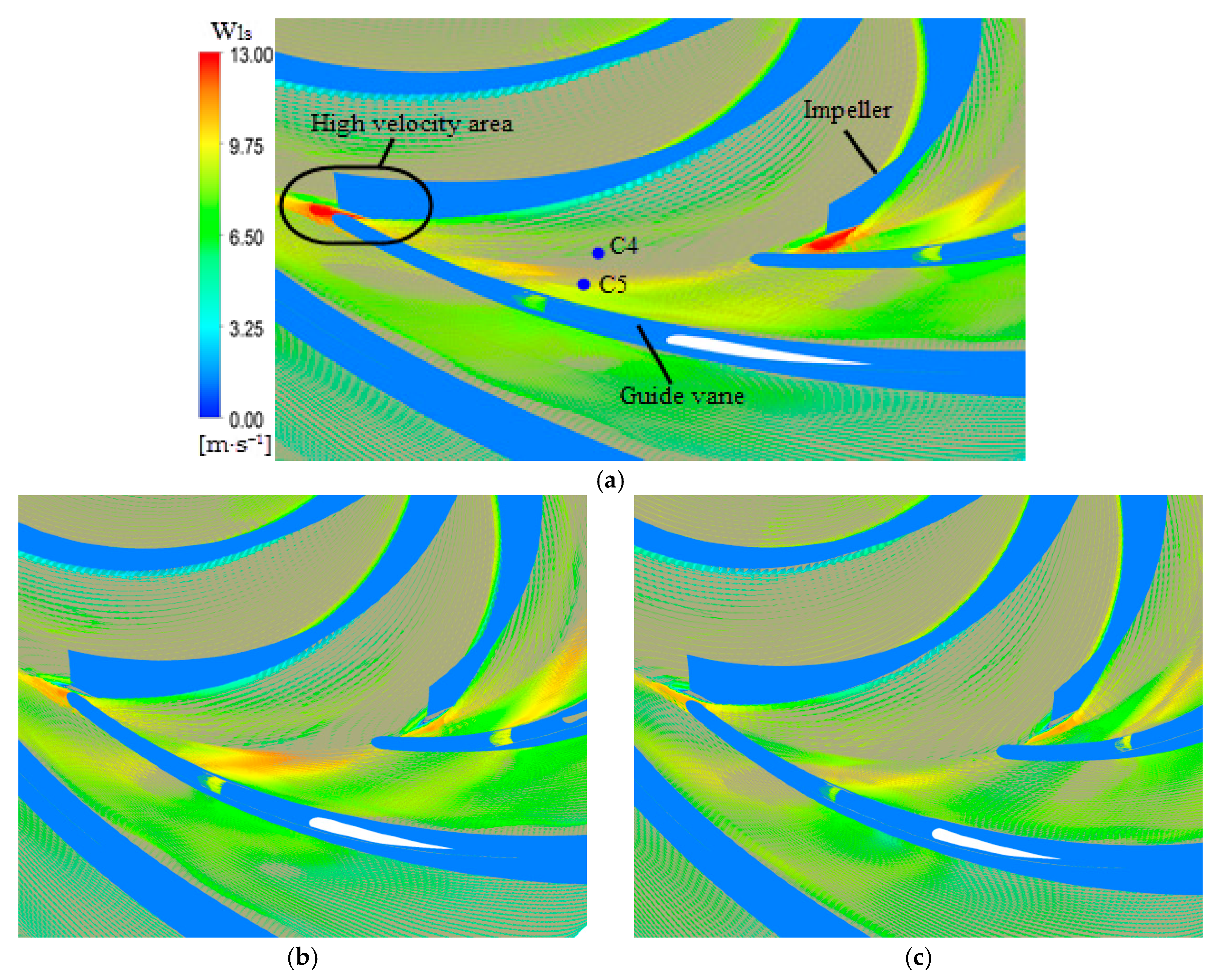

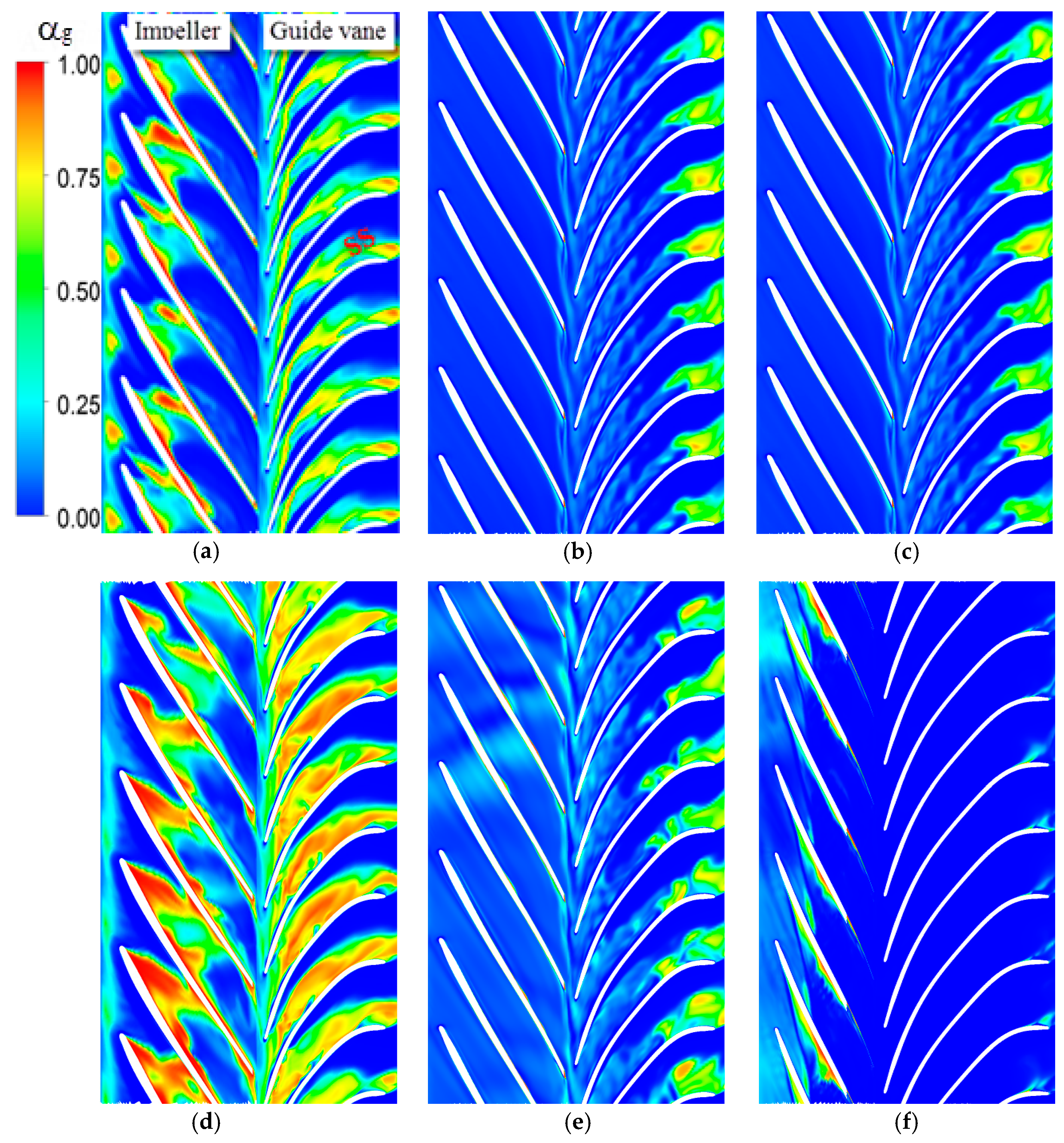
| Parameters | Notations | Values |
|---|---|---|
| Time step | Δt | 0.0002 s |
| Maximum iteration number per time step | N | 20 |
| Total time | T | 0.3 s |
| Residual | RMS | <1 × 10−4 |
| Total flow rate | Qt | 23.2 kg/s |
| Inlet gas void fraction | IGVF | 0%, 5%, 10% |
| Points | C1 | C2 | C3 | C4 | |
|---|---|---|---|---|---|
| IGVF | |||||
| 0% | 0.20 | 0.26 | 0.36 | 3.52 | |
| 5% | 0.52 | 0.53 | 0.58 | 2.46 | |
| 10% | 2.13 | 1.86 | 1.48 | 3.44 | |
| Points | C5 | C6 | C7 | C8 | C9 | |
|---|---|---|---|---|---|---|
| IGVF | ||||||
| 0% | 2.29 | 2.12 | 1.48 | 0.73 | 0.20 | |
| 5% | 1.68 | 1.43 | 0.94 | 0.48 | 0.21 | |
| 10% | 2.03 | 1.16 | 1.11 | 0.46 | 0.43 | |
© 2017 by the authors. Licensee MDPI, Basel, Switzerland. This article is an open access article distributed under the terms and conditions of the Creative Commons Attribution (CC BY) license (http://creativecommons.org/licenses/by/4.0/).
Share and Cite
Zhang, W.; Yu, Z.; Zhu, B. Numerical Study of Pressure Fluctuation in a Gas- Liquid Two-Phase Mixed-Flow Pump. Energies 2017, 10, 634. https://doi.org/10.3390/en10050634
Zhang W, Yu Z, Zhu B. Numerical Study of Pressure Fluctuation in a Gas- Liquid Two-Phase Mixed-Flow Pump. Energies. 2017; 10(5):634. https://doi.org/10.3390/en10050634
Chicago/Turabian StyleZhang, Wenwu, Zhiyi Yu, and Baoshan Zhu. 2017. "Numerical Study of Pressure Fluctuation in a Gas- Liquid Two-Phase Mixed-Flow Pump" Energies 10, no. 5: 634. https://doi.org/10.3390/en10050634






